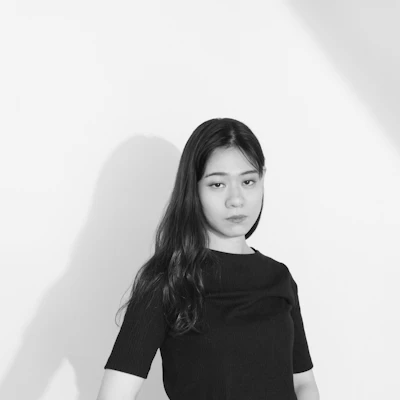01.08THU
2024.05.10
Relay Column: Clothing & Figures (Reina Mikame)

PROFILE

Reina Mikame
A painter from Aichi Prefecture, Reina Mikame graduated with a master's degree from the Tokyo University of the Arts. She primarily explores the relationship between perception and image through her works titled "色を見る" (literally, Seeing Color) and "線を見る" (literally, Seeing Lines). In addition to solo exhibitions and presentations at art fairs both in Japan and internationally, she provides artwork for books, catalogues, and videos, and also collaborates with fashion brands. Her first book, "スタジオと絵を思考する," is scheduled for publication this May.
Profile Photo: ©Mai Komura
About twice a week in her studio, Reina uses shears to cut rolled-up fabric into mostly squares according to a set ratio, starting from widths just under two meters. These cuts are destined for canvas frames, tailored to suit her painting needs.
Today, let's delve into the relationship between fabric, which predominantly constitutes both clothing and paintings, and the figures painted on them.
Today, let's delve into the relationship between fabric, which predominantly constitutes both clothing and paintings, and the figures painted on them.
Painting canvases are typically either rectangular wooden frames or wooden panels covered with fabric. Fabric edges are fixed to the frame with stainless steel tacks on one side only, resembling a drumhead as she proceeds with her painting. The materials supporting the paint, such as fabric, wood, and paper, are referred to as substrates, and the fabric substrates alone are called canvases. This term originates from the hemp canvas material, and historically, hemp is commonly used for these surfaces. After extensive research on materials, cotton fabric has also become widely used, and now canvases may even include synthetic fiber blends. Over time, paintings have transitioned from being on walls and panels to more portable and lighter fabrics.
CONCEPT VIDEO
"fashion tech news" Unveils New Logo & Concept Video
TOP ARTICLES
RELATED ARTICLES
CONCEPT VIDEO
"fashion tech news" Unveils New Logo & Concept Video
CONTACT
If you have any questions or enquiries, please enter your details in the form below.








.jpg?w=400&fm=webp)

.jpeg?w=400&fm=webp)




.JPG?w=400&fm=webp)

.png?w=400&fm=webp)

